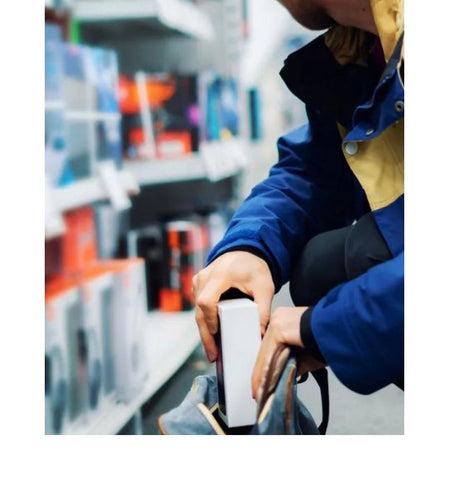In recent years, retailers nationwide have witnessed a notable uptick in shoplifting incidents, a trend that poses significant challenges to their operations and profitability. This blog aims to explore the multifaceted nature of this surge, delving into the various factors contributing to the rise of shoplifting. We will also provide practical strategies for retailers to mitigate risks and safeguard their merchandise. By understanding the underlying issues and implementing effective countermeasures, businesses can create a more secure and profitable retail environment.
How Big Is the Problem?
Shoplifting is becoming a real issue all across the UK with it regularly increasing in the past three years, rising 25% in 2023. It’s costing retailers a large amount of money and becoming a real issue for employees as well, with them facing threats, abuse, and even violence. This could be down to a lack of consequences for offenders, an impact of the cost-of-living crisis or inflation, but BRC has said that the situation has escalated to a “crisis”. In 2022, after campaigning for a standalone offence for violence against retail workers, they helped to secure an amendment to the Police, Crime, Sentencing and Courts Act that protects retail workers. This hasn’t seemed to halt the lawbreakers as more than 400,000 offences were recorded which is the highest number since records began in 2002.

Understanding the Impact
On Retailers
Shoplifters have increasingly impacted retailers across England and Wales, with a notable surge of incidents reported in 2023. This rise in theft has significantly affected retail operations and profitability. The direct loss of merchandise due to shoplifting leads to considerable financial strain, compelling retailers to raise prices to offset the losses, which can alienate loyal customers and reduce sales. Moreover, the heightened threat necessitates increased spending on security measures, such as surveillance and anti-theft systems, further diminishing profit margins. The need for stricter security and return policies can create an unwelcoming atmosphere for shoppers, impacting the overall shopping experience and potentially leading to a decline in foot traffic. The cumulative effect of these challenges can seriously harm a retailer's reputation and long-term viability, making the rise in shoplifting a critical concern for the retail sector in the region.
On Consumers
The impact of shoplifting can also harm consumers and the amount they end up getting charged when shopping. When items are stolen, retailers are forced to increase prices to recoup losses, leading to higher costs for law-abiding shoppers. In addition, persistent shoplifting can lead to stores implementing stringent security measures, such as the installation of surveillance cameras, security tags on merchandise, and increased personnel on the shop floor, which can create an atmosphere of distrust and inconvenience for customers. In areas with high rates of theft, retailers may choose to reduce their operating hours or close stores altogether, limiting access to goods and services for the local community. Consequently, while the direct action of shoplifting is committed by a few, the repercussions ripple through to impact the shopping experience and costs for all consumers.

How to Minimise Shoplifting
Reducing shoplifting is a critical challenge for retailers aiming to protect their assets and ensure a safe, welcoming environment for customers. By implementing strategic measures, businesses can significantly reduce the occurrence of theft and its associated costs. This involves a combination of adopting advanced security technologies, training staff to recognise and respond to suspicious behaviours, and designing store layouts that discourage theft. Exploring effective strategies that retailers can employ to deter shoplifters and safeguard their merchandise is key as it contributes to a more secure and profitable retail experience.
| Problem | Prevention |
|---|---|
| Shoplifting Incidents | Electronic Article Surveillance (EAS) systems. EAS systems are a cornerstone in retail theft prevention, employing tags attached to merchandise that trigger alarms when an attempt is made to remove them from the store without proper deactivation. These tags come in various forms, including magnetic, acoustic-magnetic, radio-frequency, and microwave technology, each with its unique method of detection and deactivation. |
| High-Value Items at Risk of Theft | Lockable retail display cabinets serve as a strong deterrent to potential thieves, as they restrict access only to staff members. By placing premium products in a glass display case with lights, retailers can significantly reduce the risk of theft while still allowing customers to view the merchandise. Additionally, a lockable glass display cabinet can help create an organised and attractive display that enhances the shopping experience. |
| Poor Queue Management | The implementation of physical barriers is an essential strategy in minimising shoplifting within retail environments. Retractable queue barriers serve as an efficient tool in directing customer flow and managing entry and exit points, making it more challenging for shoplifters to carry out their activities unnoticed. By utilising queue control barriers, retailers can create orderly lines, reducing the opportunities for theft by limiting access to certain areas and ensuring that customers enter and exit in an organised manner. |
| Lack of Clear Signage and Warnings | Clear signage and warnings play a pivotal role in deterring shoplifting, serving as both a legal notice and a psychological deterrent. Custom signs prominently displayed throughout a retail environment can alert potential shoplifters to the immediate and legal consequences of their actions. By clearly stating the legal repercussions and the store's commitment to prosecuting offenders, this signage can instigate a psychological response that deters theft before it occurs. |
| Financial Considerations | Investing in shoplifting prevention requires careful consideration for retailers and isn’t a decision that should be taken lightly. Initially, the outlay for security measures, such as surveillance cameras, anti-theft tags, and employee training programs, can be substantial. However, these costs must be weighed against the significant benefits of reducing merchandise loss, which can dramatically improve a store's profit margins. Moreover, effective theft prevention strategies contribute to a safer and more pleasant shopping environment, fostering increased customer trust and loyalty. This, in turn, can lead to higher foot traffic and repeat business. |
